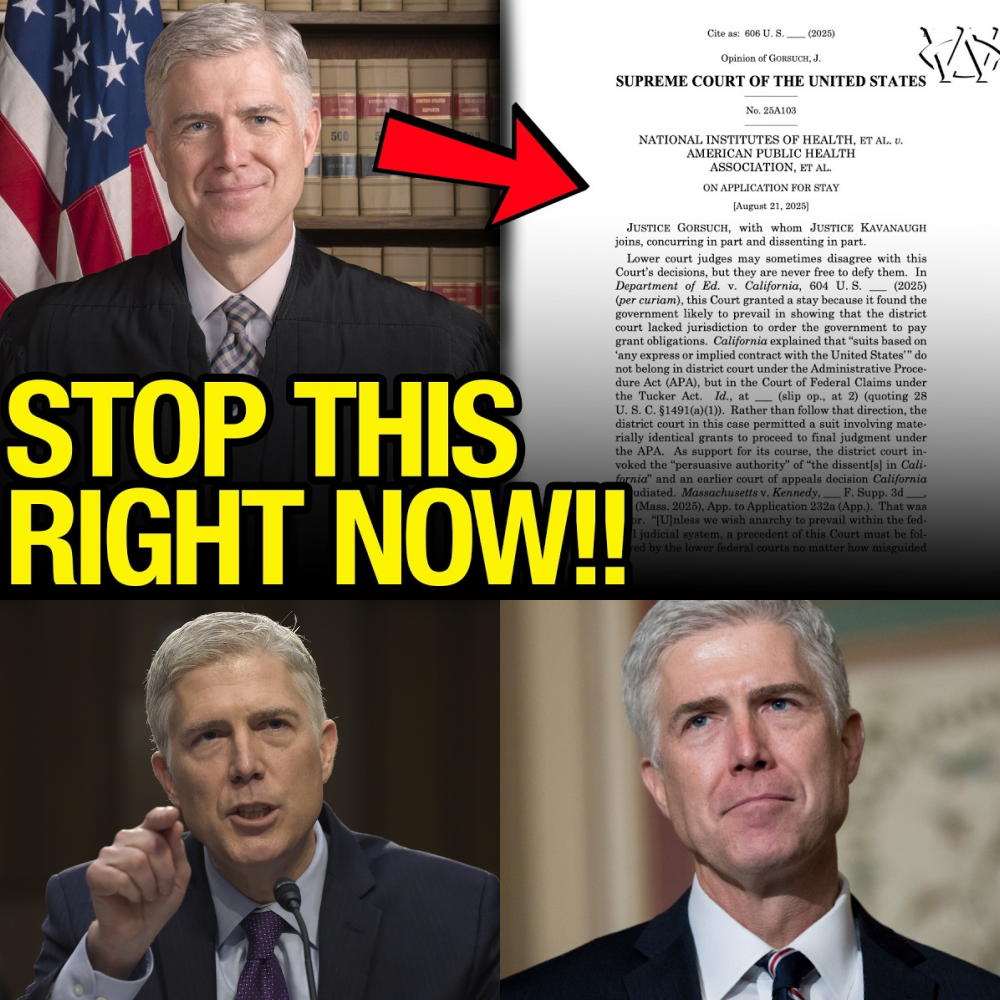
When Supreme Court Justice Neil Gorsuch speaks, the entire legal world listens. And this week, his words weren’t just pointed—they were devastating.
In a fiery opinion that has already sent shockwaves through courtrooms nationwide, Gorsuch unleashed one of the sharpest criticisms in recent memory against lower court judges who, he claims, have been openly defying Supreme Court rulings. His warning was clear: The Supreme Court sets the law of the land, and ignoring it is no longer an option.
The ruling, centered on the murky world of federal agency guidance and grant terminations, may sound technical on the surface. But dig deeper, and you’ll find a bombshell decision with sweeping implications for how government agencies, researchers, and even taxpayers interact with the law.
A Legal Earthquake in Washington
At the heart of the case was a clash between lower courts and the Supreme Court over jurisdiction—the question of which court actually has the authority to decide what. Lower courts had attempted to blur these lines, sometimes hearing claims they had no authority to decide, while ignoring the precedent set by the nation’s highest bench.
Justice Gorsuch was having none of it.
He reminded every federal judge in America that claims for monetary damages against the government belong in the Court of Federal Claims, not in district courts. Meanwhile, challenges to an agency’s guidance—like whether a federal agency overstepped its authority under the Administrative Procedure Act (APA)—can and must be handled separately.
“This isn’t optional,” Gorsuch thundered from the bench. “The Constitution and the judicial hierarchy demand it.”
Why This Matters: Agencies, Power, and Money
If you think this is just inside baseball legal jargon, think again. The ruling goes to the heart of one of Washington’s most controversial practices: how federal agencies issue guidance and decide who gets billions of dollars in taxpayer-funded grants.
During the Trump administration, agencies like the National Institutes of Health (NIH) shifted funding priorities—sometimes abruptly ending long-standing research grants. Scientists sued, arguing that agencies were abusing their power. Lower courts, often sympathetic to the researchers, blurred the lines by treating grant terminations and agency guidance as one giant problem.
But the Supreme Court has now made it clear: Not so fast.
Challenges to grant terminations go one way, challenges to guidance documents go another. And if you don’t file your claim in the right court? Too bad—your case is dismissed.
Justice Jackson’s Dissent: A Warning Sign?
Not everyone on the Court agreed. Justice Ketanji Brown Jackson, in a passionate dissent, argued that the majority’s ruling could make it harder for everyday citizens, nonprofits, and researchers to hold agencies accountable.
By forcing litigants into separate legal arenas, Jackson warned, the Court risks creating a labyrinth so complex that only the wealthiest organizations will be able to fight back.
She also raised a broader concern: if courts too easily vacate agency guidance documents, it could cripple federal agencies’ ability to act quickly on pressing issues—whether it’s public health, environmental regulation, or national security.
Barrett, Roberts, and Kavanaugh Draw the Line
Justice Amy Coney Barrett was quick to back Gorsuch, emphasizing that separating claims isn’t just a technicality—it’s the backbone of fair judicial process.
Chief Justice John Roberts, who often seeks consensus, reinforced the majority’s decision by pointing out that treating everything as one big case invites chaos. He stressed that each claim must be judged on its own merits, in its proper courtroom.
Justice Brett Kavanaugh went even further, suggesting that even if litigants managed to file their claims correctly, most would still lose on the merits—because agency guidance, while not law, often rests on strong statutory authority.
Gorsuch’s Scathing Rebuke of Lower Courts
But the headline of the day was Gorsuch’s blistering rebuke of lower courts.
He accused them of deliberately misreading precedent, undermining the authority of the Supreme Court, and in some cases, bending the law for political purposes.
“Lower courts do not get to pick and choose which Supreme Court precedents they follow,” Gorsuch wrote. “The integrity of the federal judiciary depends on adherence to constitutional hierarchy. Anything less erodes the rule of law.”
It was a statement that left no wiggle room—and plenty of judges squirming.
The Bigger Picture: Politics, Power, and Precedent
This ruling comes at a time when public confidence in the judiciary is under unprecedented strain. Accusations of political bias, forum shopping, and inconsistent rulings have created a sense of legal chaos.
By stepping in forcefully, Gorsuch and the majority are attempting to restore order. But critics argue that the decision may only deepen divides, especially as litigants face higher legal hurdles just to get their cases heard.
Still, one thing is clear: the Supreme Court is not backing down.
The Takeaway: Respect the Chain of Command—or Pay the Price
For lawyers, judges, and agencies across the nation, the message could not be clearer. If you want to challenge agency guidance, do it in one courtroom. If you want money damages, go to another. And if you ignore this rule, don’t expect sympathy from the Supreme Court.
As Justice Gorsuch made abundantly clear, defying the Court is no longer an option.
In an era when politics, law, and public trust often collide, this ruling is more than just a technical clarification—it’s a line in the sand.
And the next time a lower court thinks about ignoring Supreme Court precedent? They may think twice, knowing Justice Gorsuch is ready to shred them again.